Study on Influencing Factors and Prediction of Tunnel Floor Heave in Gently Inclined Thin-Layered Rock Mass
Abstract
:1. Introduction
2. Statistical Analysis of Tunnel Floor Heave
2.1. Statistical Analysis of Tunnel Floor Heave Locations
2.2. Statistical Analysis of Influencing Factors of Tunnel Floor Heave
2.3. Statistical Analysis of Tunnel Floor Heave during Operation
- (1)
- Among the 14 tunnels surveyed, a total of 39 instances of tunnel floor heave were observed, spanning 5.1 km, which represents 5.2% of the total tunnel length. The factors influencing these deformations are illustrated in Figure 1.
- (2)
- Tunnel floor heave predominantly occurs due to the gently inclined surrounding rock and the water pressure at the tunnel’s base. It is notably absent in regions characterized by large deformations, rock bursts, active fractures, or high ground temperatures in soft rock under high ground stress. While arching was observed in some gas sections, the gas itself did not contribute to tunnel floor heave.
- (3)
- There are seven sections where water pressure at the tunnel base is the primary factor (50%) and seven sections where the gently inclined surrounding rock is the main cause (50%).
- (4)
- In sections where floor heave is primarily caused by water pressure at the tunnel base, remedial measures have prevented further deformation. Conversely, in sections where gently inclined surrounding rock is the dominant factor, five tunnels were successfully stabilized following intervention, though two tunnels continue to experience arching despite the measures taken.
2.4. Statistical Analysis of Tunnel Floor Heave during Construction
- (1)
- Among the eight tunnels investigated, a total of 15 tunnel floor heaves occurred, totaling 2.9 km, accounting for 3.0% of the total length of the eight tunnels. The influencing factors are shown in Figure 2.
- (2)
- It primarily happens due to the gently inclined surrounding rock and the water pressure at the tunnel’s base.
- (3)
- There are six high-ground-stress and large-deformation sections (75%), and two gently inclined surrounding rock sections (25%).
- (4)
- The upper arch section mainly caused by high ground stress and large deformation is not abnormal at present after taking measurements; the upper arch section mainly caused by gently inclined surrounding rock was not abnormal after the measurements were taken.
2.5. Statistical Analysis of Tunnel Floor Heave in Gently Inclined Surrounding Rock
- (1)
- Depth
- (2)
- Lithology
- (3)
- Surrounding rock grade
- (4)
- Layer thickness
- (5)
- Inclination
- (6)
- Ground stress
- (7)
- Cumulative floor heave
- (8)
- Floor heave rate
3. Types and Mechanism of Tunnel Bottom Drum
3.1. Type of Tunnel Floor Heave
3.2. Mechanism and Mechanical Model of Tunnel Floor Heave
4. Analysis on Influencing Factors of Tunnel Floor Heave in Gently Inclined Thin-Layered Surrounding Rock
4.1. Finite Element Module Method
4.2. Single-Factor Analysis
- 1)
- Tunnel floor heave characteristics under different lateral pressure coefficients
- (1)
- The tunnel floor heave value increases with the increase in the lateral pressure coefficient, and the growth rate is accelerated. When the lateral pressure coefficient increases from 0.5 to 3.0, the tunnel floor heave gradually increases from 20.42 mm to 50.04 mm, and the displacement increases by 2.45 times. When the lateral pressure coefficient increases from 1.0 to 1.5, the tunnel bottom drum increases from 22.45 mm to 27.43 mm, and the displacement increases by 1.22 times. When the lateral pressure coefficient increases from 1.5 to 2.0, the tunnel bottom drum increases from 27.43 mm to 34.59 mm, and the displacement increases by 1.26 times. When the lateral pressure coefficient increases from 2.0 to 3.0, the tunnel bottom drum increases from 34.59 mm to 50.04 mm, and the displacement increases by 1.44 times.
- (2)
- The displacement of the tunnel sidewall increases with the increase in the lateral pressure coefficient, and the left and right sides converge inward.
- 2)
- Tunnel floor heave characteristics under different rock dip angles
- (1)
- The tunnel floor heave value decreases first, then increases and then decreases with the increase in the rock dip angle, reaching the peak value of 29.58 mm when the rock dip angle is 10°.
- (2)
- When the dip angle of the rock stratum is not 0, the surrounding rock and the initial tunnel support exhibit noticeable asymmetric displacement, with greater displacement on one side of the dip. As the dip angle increases, the asymmetry in the displacement pattern first grows and then diminishes. The deformations at the left and right arch feet vary, with greater vertical displacement on the left side, leading to an increased sliding tendency between rock layers on both sides. This uneven settlement causes rock dislocation and tensile failure in the primary support structure.
- (3)
- When other conditions are held constant, increasing the rock dip angle from 5° to 25° results in tunnel floor heave ranging from a minimum of 22.99 mm at a 5° dip angle to a maximum of 29.58 mm at a 10° dip angle. The maximum value is 1.3 times greater than the minimum. Compared to the variation in tunnel floor heave under different lateral pressure coefficients, the influence of the rock dip angle is relatively minor.
- 3)
- Characteristics of tunnel floor heave under different hard rock thicknesses
- (1)
- The tunnel floor heave decreases with the increasing thickness of the hard rock layer, and the rate of decrease accelerates. When the thickness of the hard rock layer increases from 20 cm to 50 cm, transforming the layered rock mass from thin to medium–thick, the floor heave reduces from 28.28 mm to 26.92 mm, a decrease of 4.8%. As the thickness increases further from 50 cm to 90 cm, transitioning the rock layer from medium–thick to thick, the tunnel floor heave continues to diminish from 26.92 mm to 24.56 mm, a reduction of 8.7%. The thicker the layer becomes, the more the layered rock approximates a homogeneous rock mass, resulting in a smaller degree of floor heave.
- (2)
- When the dip angle of the rock stratum is 0°, the layered rock mass can be considered as a flexural member under uniform load. Under high ground stress, the effect of the single-layer thickness of the layered rock on tunnel floor heave follows this pattern: the thin layer > medium–thick layer > thick layer. As the single-layer thickness of the rock mass increases, the integrity of the surrounding rock improves, its deformation resistance strengthens, and consequently, the tunnel floor heave decreases.
- (3)
- When other conditions are constant, when the thickness of hard rock increases from 10 cm to 90 cm, the minimum value of tunnel floor heave that occurs in the thickness of 90 cm is 24.56 mm, and the maximum value that occurs in the thickness of 10 cm is 28.28 mm, and the latter is 1.1 times the former. Compared with the lateral pressure coefficient and rock dip angle, the influence is small, and the influence order is the lateral pressure coefficient > rock dip angle > hard rock thickness.
- 4)
- Tunnel Bottom Drum Characteristics under Different Thin Layer Thickness
- (1)
- The tunnel floor heave increases with the increase in the thickness of the thin layer. When the thickness of the thin layer increases from 1 cm to 9 cm, the tunnel floor heave gradually increases from 15.40 mm to 30.48 mm, increasing by 198%.
- (2)
- Compared with the lateral pressure coefficient, rock dip angle, and thickness of hard rock strata, the order of influence is the lateral pressure coefficient > thin layer thickness > rock dip angle > hard rock thickness.
- 5)
- Characteristics of tunnel floor heave under different elastic modulus of surrounding rock
- (1)
- The tunnel floor heave decreases as the elastic modulus of the surrounding rock increases, with the rate of decrease accelerating. When the elastic modulus rises from 1.5 GPa to 3.65 GPa, the floor heave reduces from 30.43 mm to 29.17 mm, a 4.2% decrease. As the elastic modulus further increases from 3.65 GPa to 13 GPa, the heave drops from 29.17 mm to 15.94 mm, a reduction of 45.4%.
- (2)
- Compared with the lateral pressure coefficient, rock dip angle, hard rock thickness, and thin layer thickness, the order of influence significance is the lateral pressure coefficient > thin layer thickness > elastic modulus of surrounding rock > rock dip angle > hard rock thickness.
- 6)
- Characteristics of tunnel floor heave under different tunnel depths
- (1)
- The floor heave value of the tunnel increases with the increase in the tunnel depth, and it is basically linear.
- (2)
- In the case of other conditions being constant, when the tunnel depth increases from 100 m to 500 m, the minimum value of the tunnel floor heave that occurs at the tunnel depth of 100 m is 8.25 mm, and the maximum value that occurs at the tunnel depth of 500 m is 46.67 mm, and the latter is 5.65 times the former. Compared with the lateral pressure coefficient, rock dip angle, hard rock thickness, thin layer thickness, and elastic modulus of surrounding rock, the influence order is tunnel depth > lateral pressure coefficient > thin layer thickness > elastic modulus of surrounding rock > rock dip angle > hard rock thickness.
4.3. Multi-Factor Analysis
4.4. Influence Analysis of Support Mechanical Behavior
- (1)
- Tunnel floor heave predominantly manifests in surrounding rock of grades III and IV. However, in grade V rock, tunnel bottom sinking can occur due to the combined influence of high ground stress, tectonic stress, deviatoric stress, and the timing of support installation. This phenomenon is consistent with previous field investigation findings.
- (2)
- As illustrated in Figure 16, the application of secondary lining, in contrast to solely relying on initial support, can significantly mitigate tunnel floor heave. The effectiveness of this mitigation becomes more pronounced with an increase in the lateral pressure coefficient and the deterioration of surrounding rock conditions. For instance, when the lateral pressure coefficient is 1.0, floor heave ranging from 1 to 6 mm can be somewhat reduced. At a lateral pressure coefficient of 2.0, the floor heave in the range of 6 to 12 mm can be curtailed to some extent. When the lateral pressure coefficient reaches 3.0, the reduction in floor heave spans 12 to 22 mm, depending on the degree of the condition. Furthermore, under grade III surrounding rock conditions, floor heave in the range of 1 to 14 mm can be mitigated to varying degrees. This reduction is more pronounced under grade IV surrounding rock conditions, where floor heave ranging from 1 to 30 mm can be diminished to different extents.
- (3)
- While the initial support, secondary lining structure, and inverted arch filling layer all effectively suppress tunnel floor heave, the disparity between the initial support and secondary lining structure is minimal. The difference typically ranges from 0.09 to 6 mm, following a trend similar to the one previously described. In most instances, this difference is within the 0.09 to 1.5 mm range. However, when the lateral pressure coefficient reaches 3.0 or when surrounding rock conditions deteriorate further, the disparity between the two becomes more pronounced.
5. Estimation and Prediction of Tunnel Floor Heave
5.1. Load Calculation Formula
5.2. Relationship between Stress and Displacement of Surrounding Rock Based on Nishihara Model
| Algorithm 1: The solution of support force relationship. | |
| Input: R0, k, w, G_1, G_2, n_1, n_2, a, p, t, lb, ub | |
| Output: u0, Rp | |
| /*Initialization*/ | |
| 1: | tol: f64 = 0.01;//Initialize allowable tolerance for the solution. |
| 2: | iter: uzise = 1 + (((ub − lb)/tol).log2()).floor() as usize;//Initialize maximum iteration. |
| 3: | iter0: uzise = 0;//Initialize current iteration. |
| /*Main Program*/ | |
| 4: | flb: f64 = solving_f(R0, k, w, G_1, G_2, n_1, n_2, a, p, t, lb);//Calculate minimum value of the parameter f. |
| 5: | fub: f64 = solving_f(R0, k, w, G_1, G_2, n_1, n_2, a, p, t, ub);//Calculate maximum value of the parameter f. |
| 6: | if flb ×fub > 0.0 then |
| 7: | print (“There is no solution within the given interval.”); |
| 8: | break; |
| 9: | else |
| 10: | while iter0 < iter − 1, do |
| 11: | xtry: f64 = 0.5 × (lb + ub); |
| 12: | ftry: f64 = solving_f(R0, k, w, G_1, G_2, n_1, n_2, a, p, t, xtry); |
| 13: | fb: f64 = solving_f(R0, k, w, G_1, G_2, n_1, n_2, a, p, t, lb); |
| 14: | if fb × ftry > 0.0 then |
| 15: | lb = xtry; |
| 16: | else |
| 17: | ub = xtry; |
| 18: | end |
| 19: | iter0 += 1; |
| 20: | end |
| 21: | Rp: f64 = xtry; |
| 22: | u0: f64 = solving_u0(t, R0, k, w, G_1, G_2, n_2, a, Rp); |
| 23: | end |
| 24: | returnu0, Rp |
| /* User-defined Functions*/ | |
| 25: | fn solving_f(R0: f64, k: f64, w: f64, G_1: f64, G_2: f64, n_1: f64, n_2: f64, a: f64, p: f64, t: f64, Rp: f64) → f64 |
| 26: | { |
| 27: | Solve Equations (1)–(10) to obtain the value of parameter f; |
| 28: | return f |
| 29: | } |
| 30: | fn solving_u0(t: f64, R0: f64, k: f64, w: f64, G_1: f64, G_2: f64, n_2: f64, a: f64, Rp: f64) → f64 |
| 31: | { |
| 32: | r = ((2.0/(1.0 + k)) × (w + a)) − a; |
| 32: | y = 1.0 − (r/w); |
| 33: | Solve Equation (21) to obtain the value of parameter u0; |
| 34: | return u0; |
| 35: | } |
5.3. Estimation of Tunnel Floor Heave Based on Deformation Statistics
5.4. Intelligent Prediction Model of Tunnel Bottom Drum Based on BP Algorithm
6. Discussion
- (1)
- This study is grounded in extensive on-site investigations and long-term monitoring data, elements often lacking or overlooked in the existing literature. The findings indicate that during both the construction and operation stages, gently inclined thin rock masses are the primary cause of tunnel floor heave. This discovery marks a significant advancement in understanding tunnel floor heave and further deepens the insights from previous research. Consequently, this study focuses on the dynamic interaction between the gently inclined thin rock mass structure and the tunnel structure, exploring the mechanisms of their interaction and the progressive failure processes. These aspects are addressed in greater scientific detail than in previous studies.
- (2)
- To analyze the factors influencing tunnel floor heave in gently inclined thin rock masses, this study incorporates a broader range of variables using field monitoring data, numerical simulations, and orthogonal testing. Building on previous research, this study evaluates both single-factor and multi-factor interactions to rank the influencing factors of tunnel floor heave. This approach enhances the scientific rigor, accuracy, and applicability of the findings. Additionally, this study examines the dynamic coordination between surrounding rock and support systems through a comprehensive system analysis. The results are validated against field investigations and monitoring, offering new insights not covered in earlier studies and contributing to the advancement in this field.
- (3)
- A mechanical model for gently inclined thin-layered rock masses is developed based on the circumcircle theory of tunnels and the principles of active and passive rock and soil pressures. This model, building on previous research, elucidates the dynamic relationship between the ultimate load capacity and the deformation limits of the tunnel floor, thereby offering a more comprehensive understanding of stress redistribution in gently inclined rock strata. Additionally, using the Nishihara model, this study characterizes the viscoelastic–viscoplastic mechanical behavior of the tunnel floor under varying stress conditions, addressing a significant gap in the field.
- (4)
- While the application of load-displacement inversion formulas and intelligent models in tunnel engineering has been extensively studied, significant challenges remain, particularly due to the complexity of tunnel construction parameters and the variability of influencing factors. Consequently, these mechanical formulas and intelligent prediction models have not achieved the desired success rate in practice and have struggled to effectively guide real-world applications. However, the load-displacement inversion formula and intelligent prediction model for tunnel floor heave introduced in this paper have been validated and widely implemented in numerous practical projects, representing a substantial advancement in the field.
- (5)
- The numerical analyses conducted using FLAC3D and ANSYS corroborate the findings of Liu et al. [1], Sakhno et al. [2], and Perry et al. [3], who demonstrated the significant impact of construction schemes, rock moisture content, and control measures on tunnel floor heave. Our study builds on these foundational works by incorporating a broader range of variables and by focusing specifically on the most vulnerable rock formations. In particular, this study’s exploration of the dynamic interplay between tunnel floor load capacity, deformation limits, and surrounding rock support provides a more comprehensive understanding of the stress redistribution that occurs in gently inclined rock strata, as highlighted in earlier studies [9,10,11,12,13].
- (6)
- Furthermore, our research underscores the limitations of current artificial intelligence applications in predicting mechanical behavior in tunnel engineering. While machine learning models, such as those developed by Lu et al. [17] and Min et al. [19], have shown promise in geomechanics, this study reveals the challenges of directly applying these models to practical engineering projects. Specifically, the complex interactions between geological variables and construction parameters in real-world scenarios necessitate a more nuanced approach than current AI models can offer.
- (7)
- This study’s use of advanced analytical models, including the application of the Nishihara model and the development of new creep constitutive equations, represents a significant step forward in understanding the viscoelastic–viscoplastic behavior of tunnel floors under varying stress conditions. These findings extend the work of Gao et al. [26], Zhu et al. [27], and Xia et al. [28] by offering refined models that better capture the behavior of soft rock in tunnel environments.
7. Conclusions
- (1)
- Through an extensive investigation and statistical analysis, it has been observed that tunnel floor heave deformation is significantly influenced by the interplay of multiple fields, particularly the stress and seepage fields. This phenomenon is prevalent in both railway tunnels during construction and operational phases, especially when the surrounding rock consists of gently inclined, thin-layered formations. The effectiveness of repair measures in such conditions remains unsatisfactory, indicating a need for further study and improvement.
- (2)
- Based on comprehensive field monitoring and numerical simulations, an analysis of the engineering characteristics of gently inclined, thin-layered rock masses was conducted. Through both single-factor and multi-factor analyses, six primary factors influencing floor heave in tunnels with such surrounding rock were identified: the lateral pressure coefficient, rock layer dip angle, hard rock layer thickness, thin layer thickness, elastic modulus of surrounding rock, and tunnel burial depth. The ranking of these factors in order of importance is as follows: tunnel burial depth > lateral pressure coefficient > thin layer thickness > surrounding rock elastic modulus > rock layer dip angle > hard rock layer thickness. A further analysis of the support system’s mechanical behavior revealed that tunnel floor heave predominantly occurs in tunnels with grade III and IV surrounding rock. In contrast, tunnels with grade V surrounding rock experience subsidence at the floor due to the combined effects of high ground stress, tectonic stress, deviatoric stress, and the timing of support application. Compared to primary support structures, the combination of primary support and secondary lining can more effectively mitigate tunnel floor heave.
- (3)
- Grounded in the theory of a tunnel circumcircle and the principles of active and passive pressures in rock and soil, this study examines the structure and long-term stability of tunnel floors. This research uncovers the deformation mechanisms and ultimate bearing capacity of tunnel floors under the conditions of gently inclined, thin-layered stratification. Additionally, using the Nishihara model, a novel creep constitutive equation has been developed to elucidate the dynamic interaction between the tunnel floor structure and the surrounding rock support forces.
- (4)
- A formula for estimating tunnel floor heave was developed using a combination of on-site monitoring, statistical analysis, numerical simulation, and BP neural network techniques. After refinement, the formula achieved a coefficient of determination (R2) of 0.95, closely aligning with actual values. This formula is capable of not only estimating the extent of tunnel floor heave but also inverting the load at the tunnel base. Additionally, an intelligent prediction model for tunnel floor heave was established using the BP neural network algorithm. Following 100,000 training iterations, the loss function value reached 0.17, enabling highly accurate predictions of tunnel floor deformation. This research has been successfully applied and promoted in practical engineering, offering a robust theoretical foundation and technical support for future tunnel construction projects.
- (5)
- Future research should focus on the following three areas:
Author Contributions
Funding
Institutional Review Board Statement
Informed Consent Statement
Data Availability Statement
Conflicts of Interest
References
- Liu, H.; Li, P.; Liu, J. Numerical investigation of underlying tunnel heave during a new tunnel construction. Tunn. Undergr. Space Technol. 2011, 26, 276–283. [Google Scholar] [CrossRef]
- Mo, S.; Ramandi, H.L.; Oh, J.; Masoumi, H.; Canbulat, I.; Hebblewhite, B.; Saydam, S. A new coal mine floor rating system and its application to assess the potential of floor heave. Int. J. Rock Mech. Min. Sci. 2020, 128, 104241. [Google Scholar] [CrossRef]
- Yang, J.; Zhou, K.; Cheng, Y.; Gao, Y.; Wei, Q.; Hu, Y. Mechanism and Control of Roadway Floor Heave in the Paleogene Soft Rock Surroundings. Geotech. Geol. Eng. 2019, 37, 5167–5185. [Google Scholar] [CrossRef]
- Sakhno, I.; Sakhno, S. Numerical studies of floor heave mechanism and the effectiveness of grouting reinforcement of roadway in soft rock containing the mine water. Int. J. Rock Mech. Min. Sci. 2023, 170, 105484. [Google Scholar] [CrossRef]
- Perry, K.; Bradley, J.; Unrug, K.; Klimek, M. Mitigation of floor heave in West Kentucky Coal Mine. Int. J. Min. Sci. Technol. 2016, 26, 521–525. [Google Scholar] [CrossRef]
- Mo, S.; Tutuk, K.; Saydam, S. Management of floor heave at Bulga Underground Operations—A case study. Int. J. Min. Sci. Technol. 2019, 29, 73–78. [Google Scholar] [CrossRef]
- Afrouz, A. Methods to reduce floor heave and sides closure along the arched gate roads. Min. Sci. Technol. 1990, 10, 253–263. [Google Scholar] [CrossRef]
- Cicek, S.; Tulu, I.B.; Van Dyke, M.; Klemetti, T.; Wickline, J. Application of the coal mine floor rating (CMFR) to assess the floor stability in a Central Appalachian Coal Mine. Int. J. Min. Sci. Technol. 2021, 31, 83–89. [Google Scholar] [CrossRef]
- Xiao, P.; Yang, X.; Li, B.; Zhou, X.; Sun, Y.; Ding, X.; Xu, N. Roof arch collapse of underground cavern in fractured rock mass: In situ monitoring and numerical modeling. J. Rock Mech. Geotech. Eng. 2024. [Google Scholar] [CrossRef]
- Zhang, J.; Du, R.; Zhang, X.; Huang, Z.; Zhang, W. The deformation and failure characteristics of tunnels in layered rock with gentle dip angles after freeze-thaw cycles: Physical model tests and numerical investigation. Tunn. Undergr. Space Technol. 2024, 144, 105527. [Google Scholar] [CrossRef]
- Zhou, X.; Meng, F.; Xiu, Z.; Yue, Z.; Wang, W.; Cui, G.; Wang, Z. Study on the influence of dip angle of tunnel surrounding rock structural plane on induced rockburst. J. Water Resour. Archit. Eng. 2023, 21, 94–100. [Google Scholar]
- Liu, Y.; Chen, B.; Zhang, Z. Deformation and crack development law of tunnel bottom structure in gently inclined layered rock mass. Railw. Eng. 2023, 63, 104–108. [Google Scholar]
- Zhang, P. Experimental Study on Tension-Compression Characteristics and Failure Law of Gently Inclined Layered Rock; 2022.
- Schumacker, R.; Tomek, S. F-Test. In Understanding Statistics Using R; Springer: New York, NY, USA, 2013; Available online: https://link.cnki.net/doi/10.27661/d.cnki.gzhnu.2022.004720 (accessed on 29 August 2024).
- Li, J.; Cheng, J.-H.; Shi, J.-Y.; Huang, F. Brief Introduction of Back Propagation (BP) Neural Network Algorithm and Its Improvement. In Advances in Computer Science and Information Engineering; Springer: Berlin/Heidelberg, Germany, 2012. [Google Scholar]
- Li, C. Research on Floor Heave Prediction and Support Countermeasures of Soft Rock Roadway. Coal Sci. Technol. Mag. 2021, 42, 24–27. [Google Scholar] [CrossRef]
- Lu, J.; Xiao, Z.; Yu, Y.; Yuan, W. Study on creep parameter inversion method of surrounding rock in floor heave section of railway tunnel. J. Railw. Eng. Soc. 2021, 38, 66–71. [Google Scholar]
- Huang, H.; Wu, C.; Zhou, M.; Chen, J.; Han, T.; Zhang, L. Rock mass quality prediction on tunnel faces with incomplete multi-source dataset via tree-augmented naive Bayesian network. Int. J. Min. Sci. Technol. 2024, 34, 323–337. [Google Scholar] [CrossRef]
- Min, B.; Zhang, X.; Zhang, C.; Zhang, X. Prediction of bearing capacity of cracked asymmetrical double-arch tunnels using the artificial neural networks. Eng. Fail. Anal. 2024, 156, 107805. [Google Scholar] [CrossRef]
- Savvides, A.-A.; Antoniou, A.A.; Papadopoulos, L.; Monia, A.; Kofina, K. An Estimation of Clayey-Oriented Rock Mass Material Properties, Sited in Koropi, Athens, Greece, through Feed-Forward Neural Networks. Geotechnics 2023, 3, 975–988. [Google Scholar] [CrossRef]
- Chung, J.; Ahmad, R.; Sun, W.; Cai, W.; Mukerji, T. Prediction of effective elastic moduli of rocks using Graph Neural Networks. Comput. Methods Appl. Mech. Eng. 2024, 421, 116780. [Google Scholar] [CrossRef]
- Zhang, P.; Yin, Z.-Y.; Sheil, B. Interpretable data-driven constitutive modelling of soils with sparse data. Comput. Geotech. 2023, 160, 105511. [Google Scholar] [CrossRef]
- Savvides, A.A.; Papadopoulos, L. A neural network approach for the reliability analysis on failure of shallow foundations on cohesive soils. Int. J. Geo-Eng. 2024, 15, 15. [Google Scholar] [CrossRef]
- Fu, R.-c.; Wang, H.-n.; Jiang, M.-j. Exact analytical solution for deep tunnels in viscoelastic–plastic rock considering the actual loading path. Appl. Math. Model. 2024, 128, 370–391. [Google Scholar] [CrossRef]
- Ahn, K.-h.; Pouya, A. Analytical solution of circular tunnel-lining interaction with elastic contact. Tunn. Undergr. Space Technol. 2023, 140, 105311. [Google Scholar] [CrossRef]
- Gao, X.; Hu, T.; Su, Z. Nonlinear Nishihara model of soft rock based on damage mechanics and its parameter identification. Mater. Today Commun. 2024, 39, 108715. [Google Scholar] [CrossRef]
- Zhu, Z.-y.; Luo, F.; Zhang, Y.-z.; Zhang, D.-j.; He, J.-l. A creep model for frozen sand of Qinghai-Tibet based on Nishihara model. Cold Reg. Sci. Technol. 2019, 167, 102843. [Google Scholar] [CrossRef]
- Xia, C.; Liu, Y.; Wu, F.; Xu, C.; Deng, Y. Viscoelastic-viscoplastic analytical solution of circular tunnel based on Nishihara model. Rock Soil Mech. 2019, 40, 1638–1648. [Google Scholar] [CrossRef]
- Wu, L. Theory of Plates and Shells; Shanghai Jiao Tong University Press: Shanghai, China, 1989. [Google Scholar]
- Luepsen, H. ANOVA with binary variables: The F-test and some alternatives. Commun. Stat. Simul. Comput. 2023, 52, 745–769. [Google Scholar] [CrossRef]


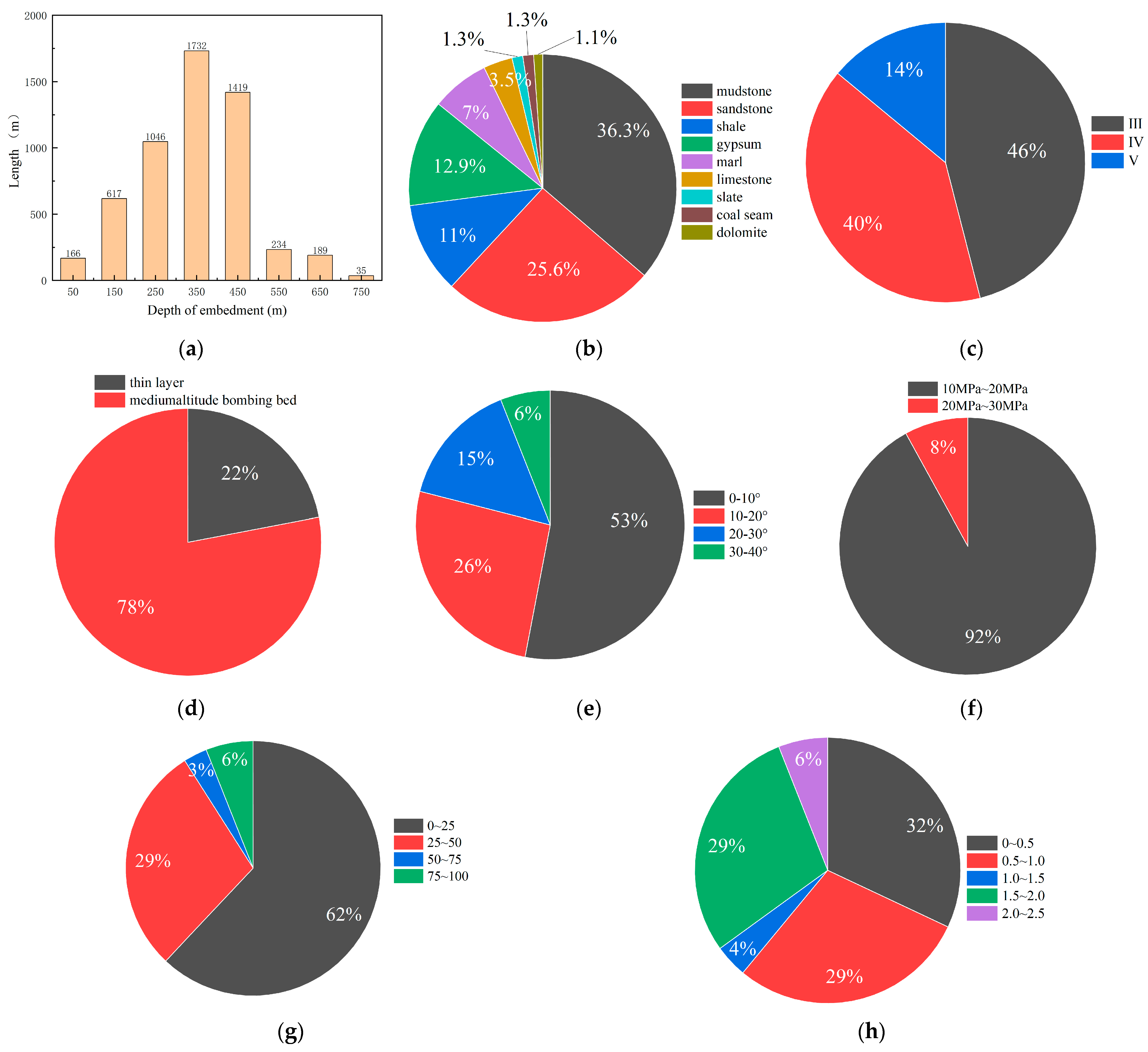



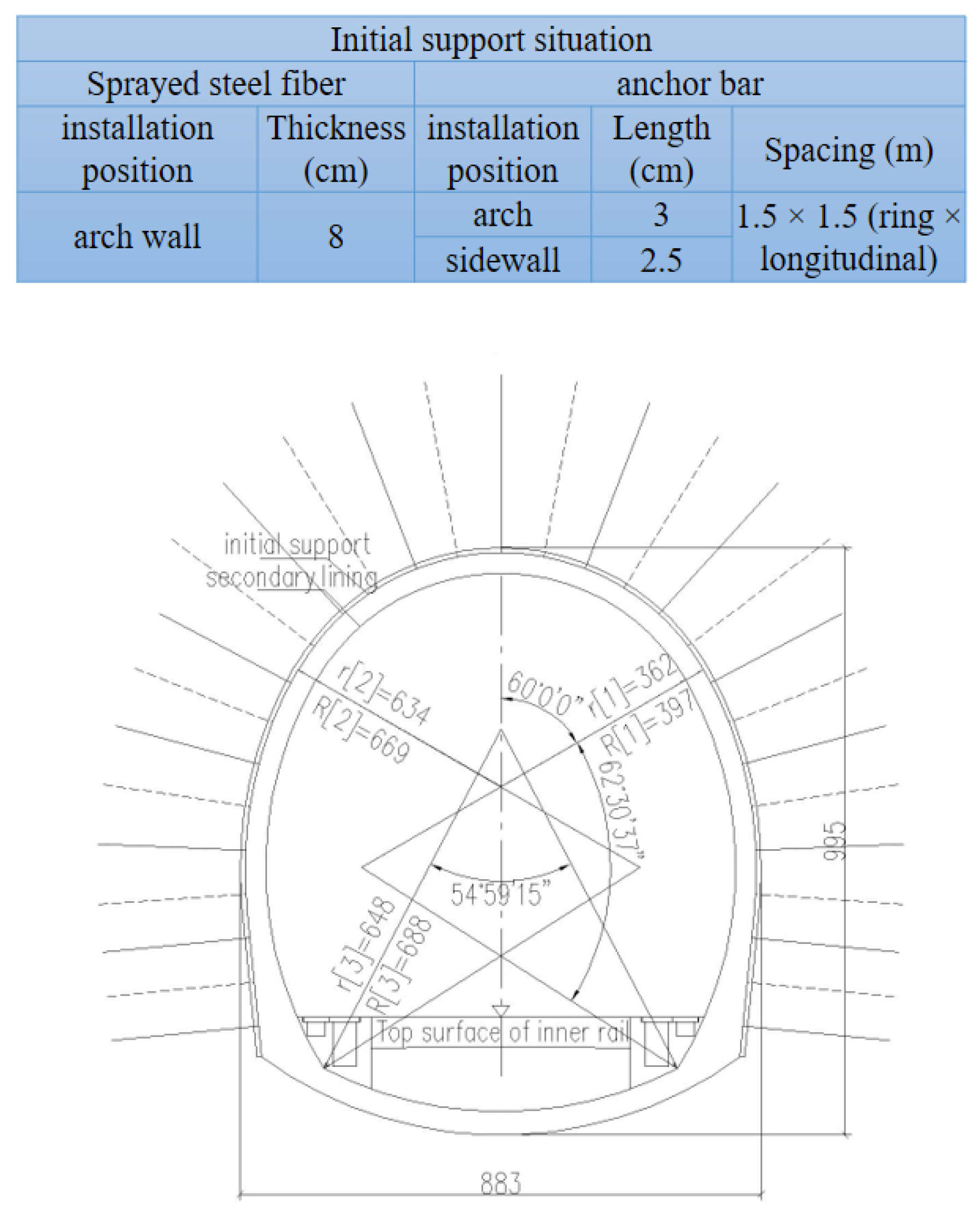
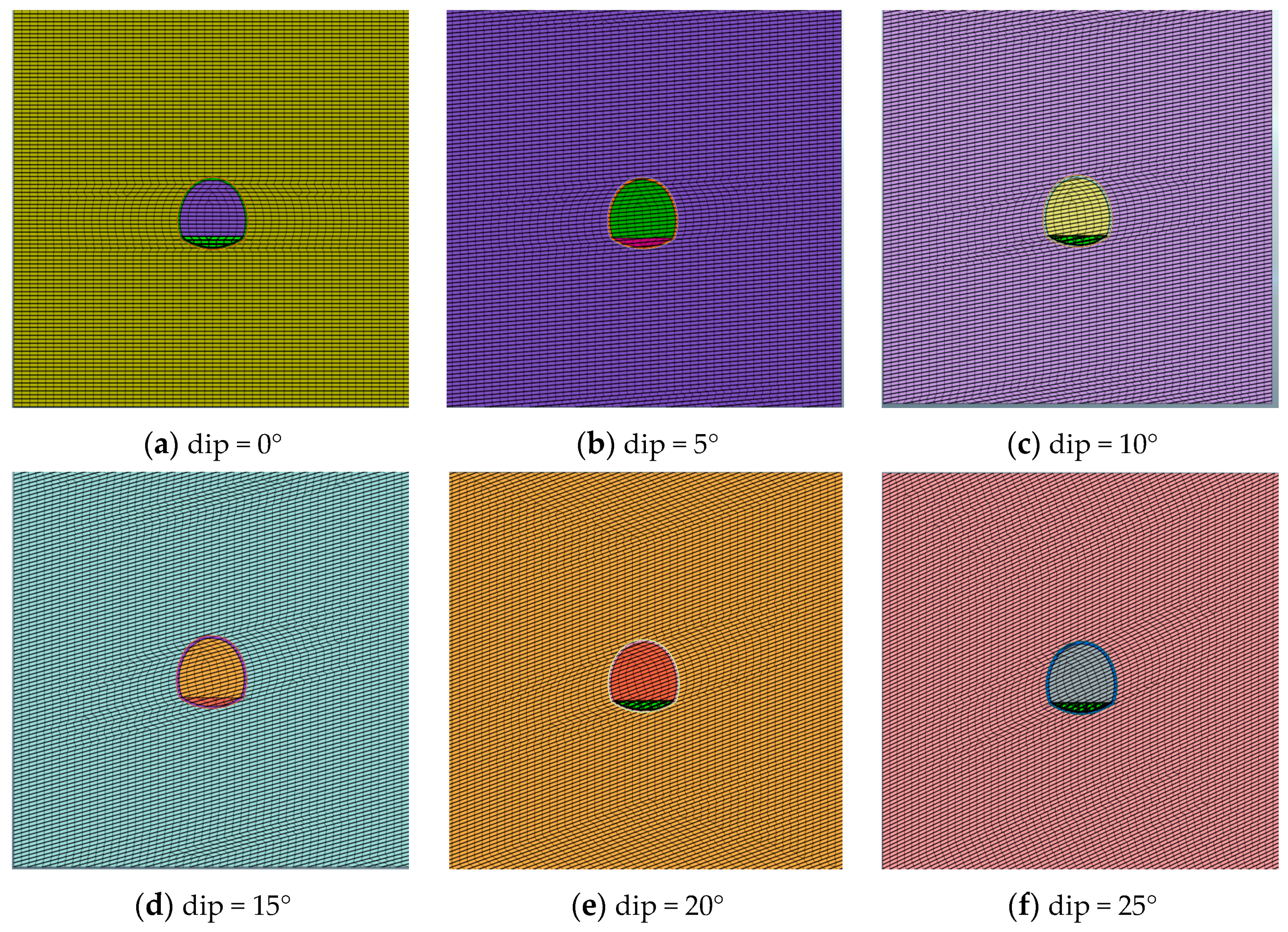

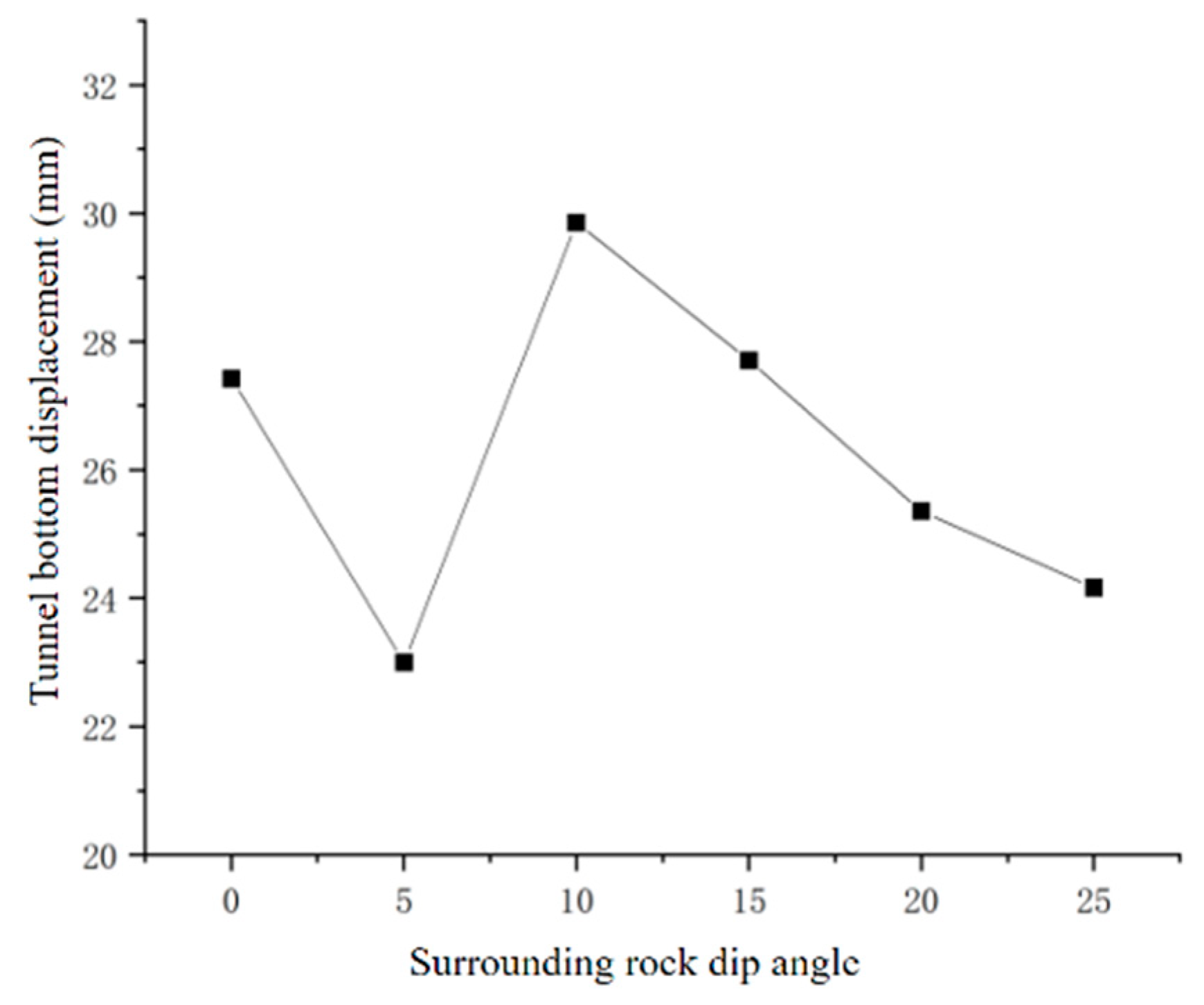
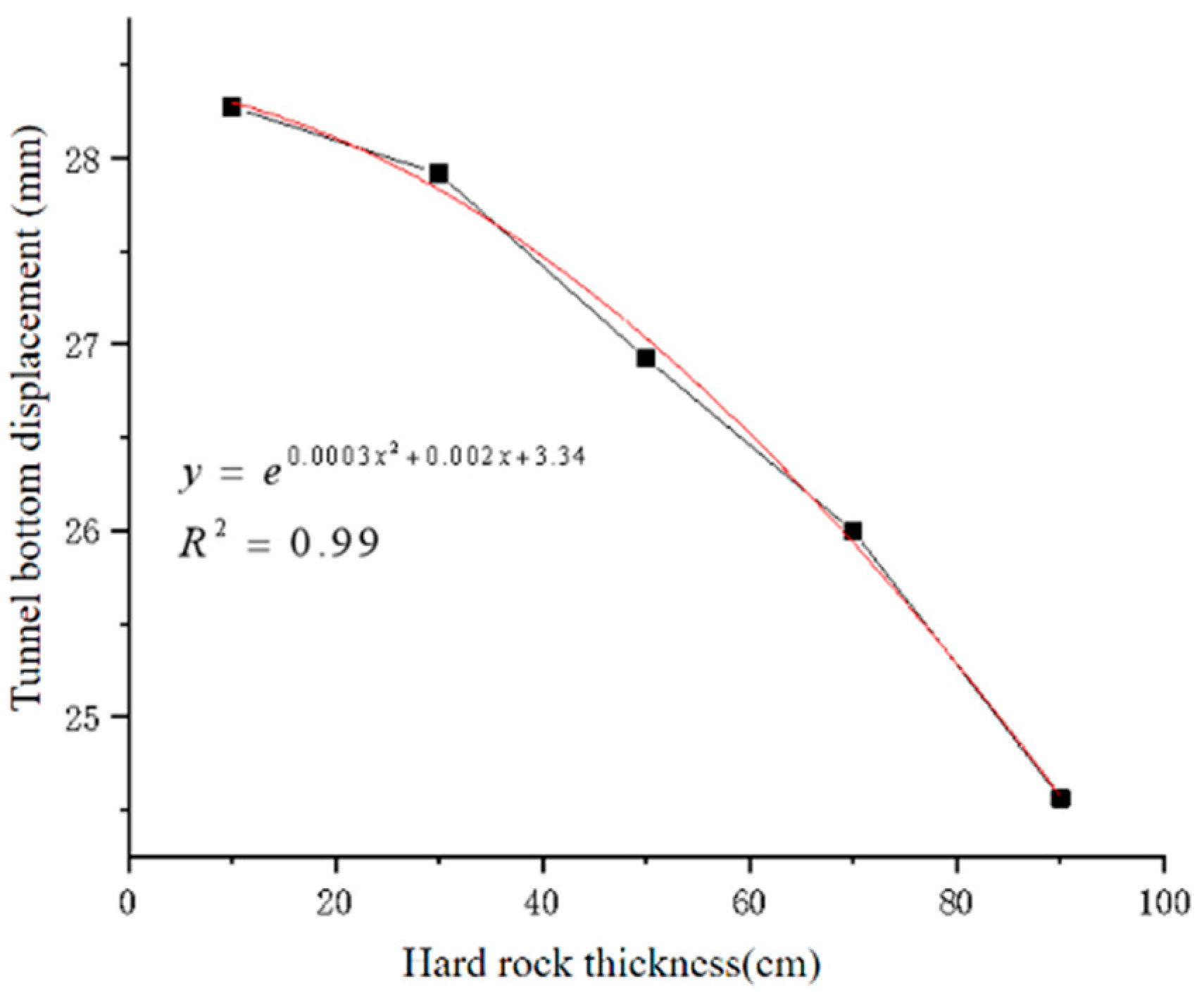



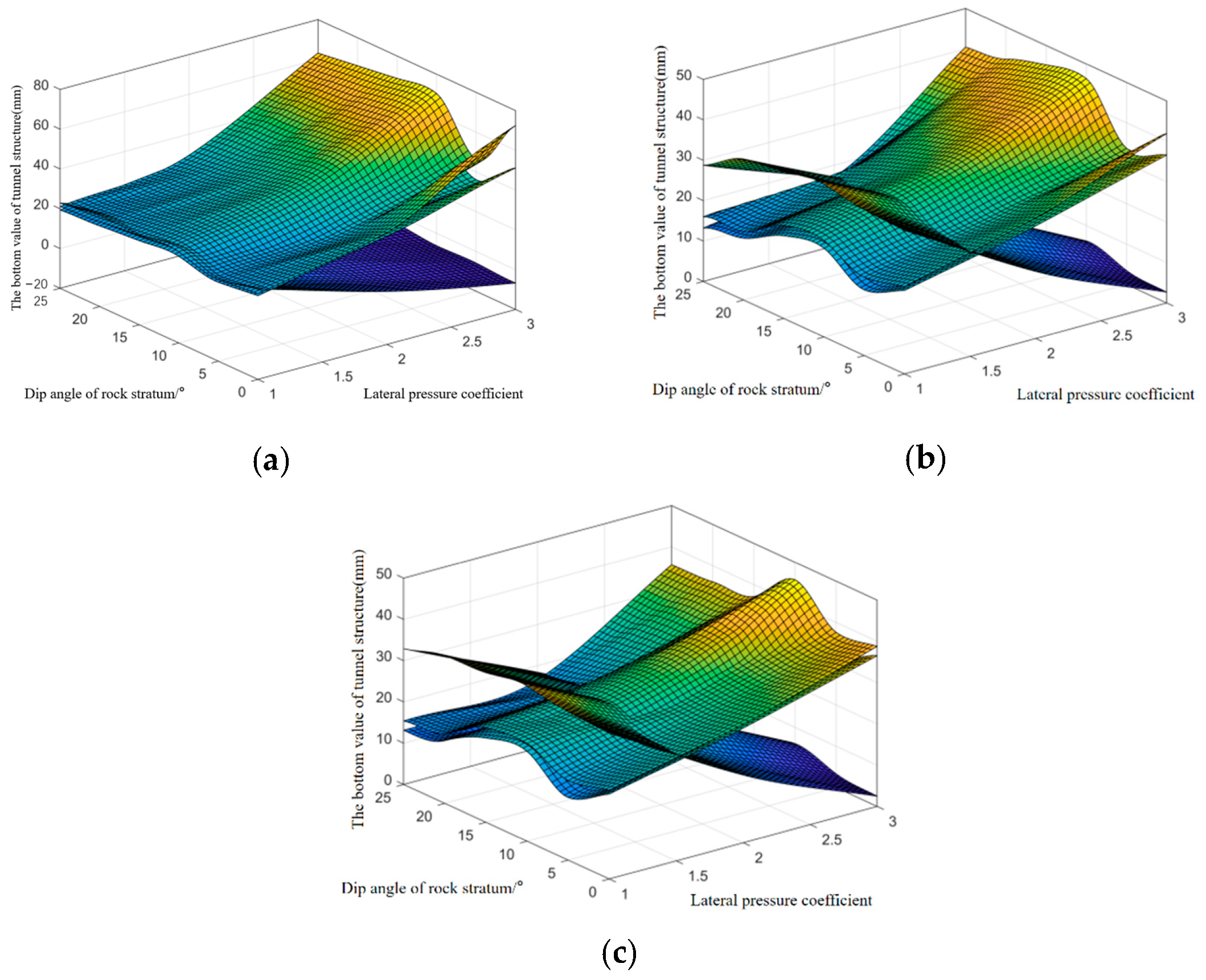


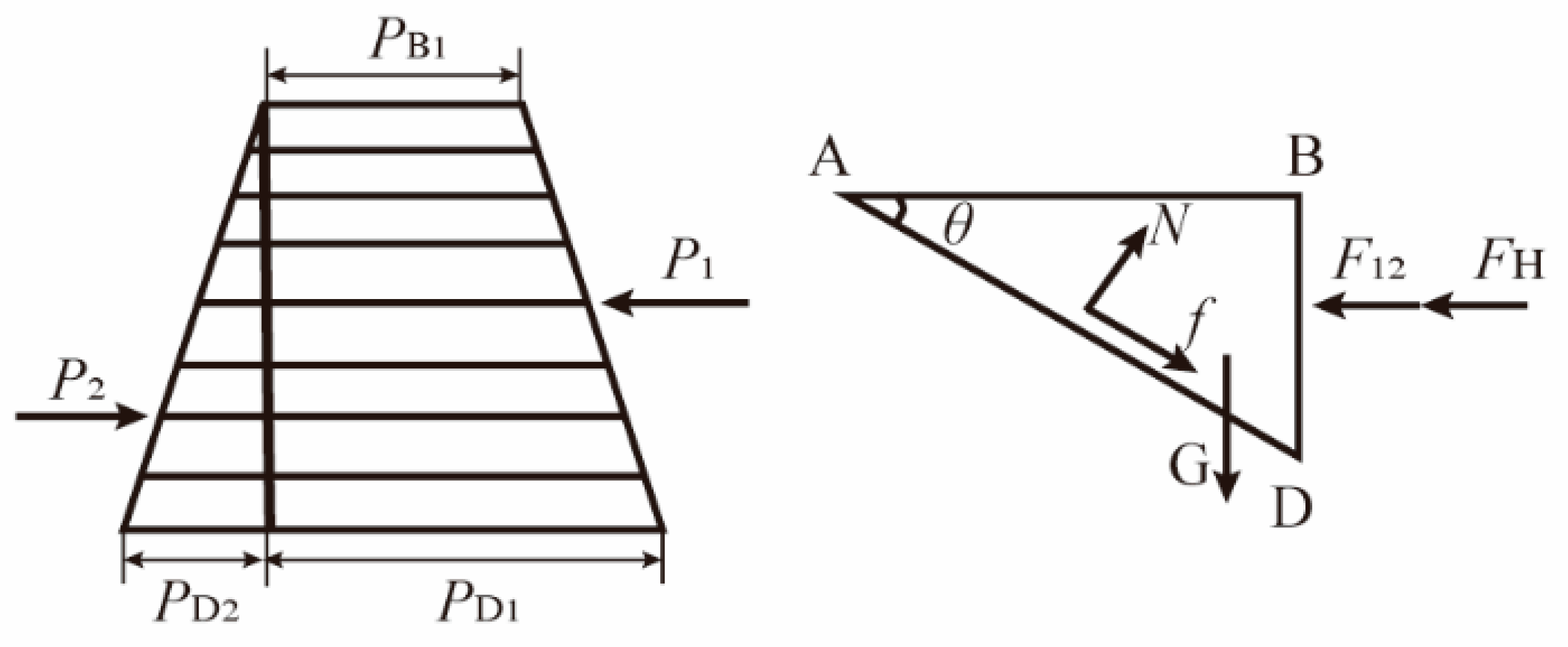
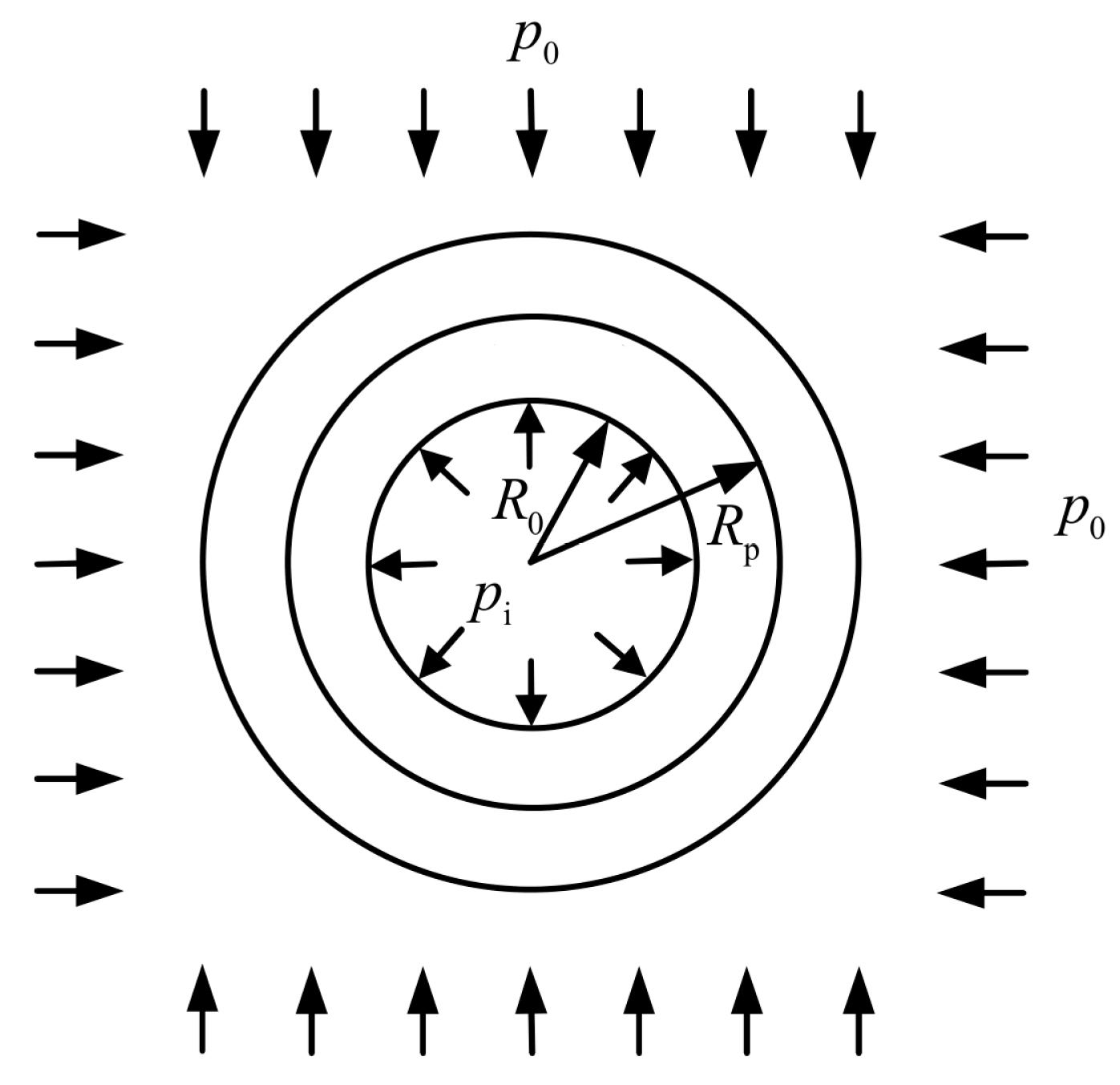

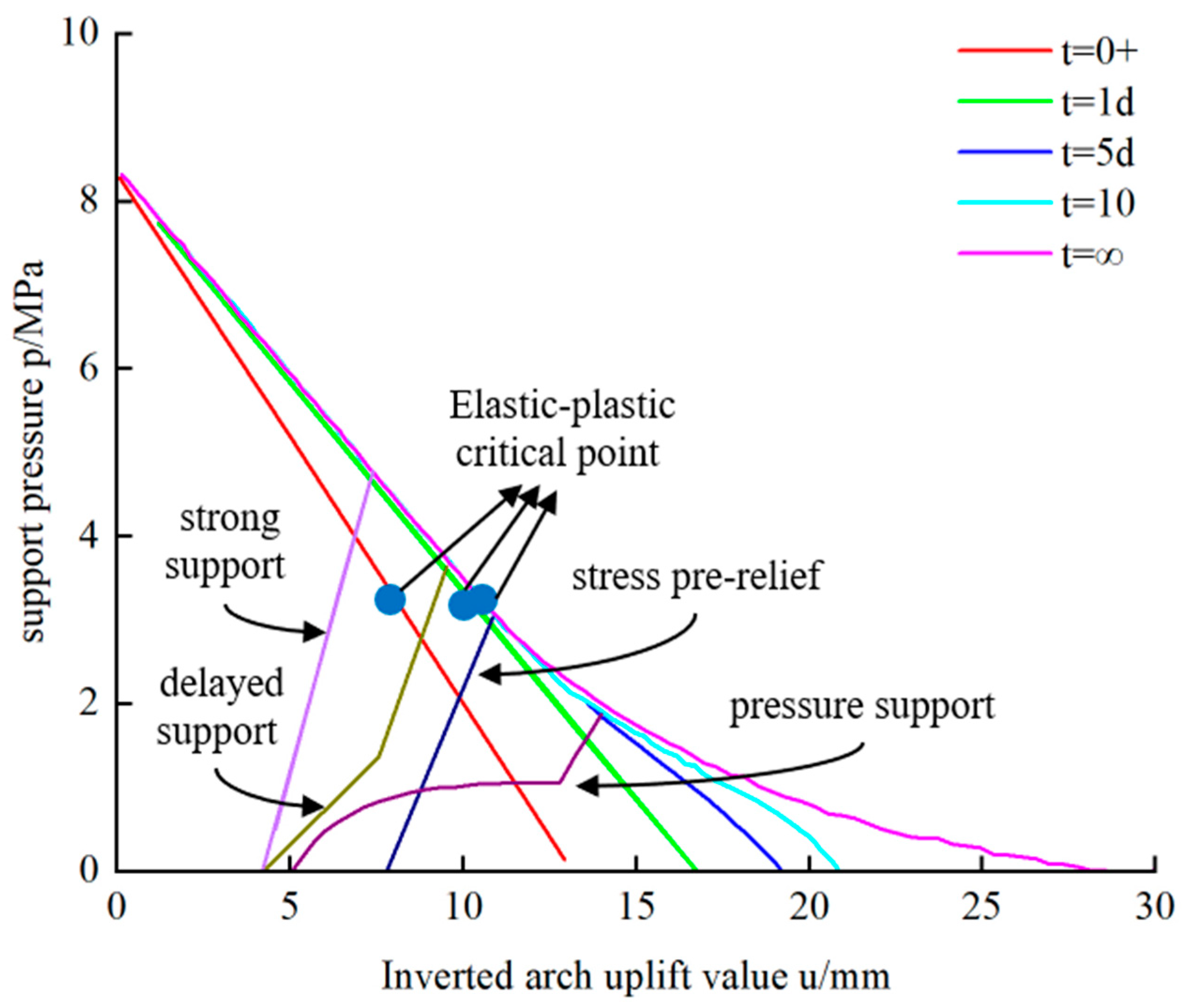
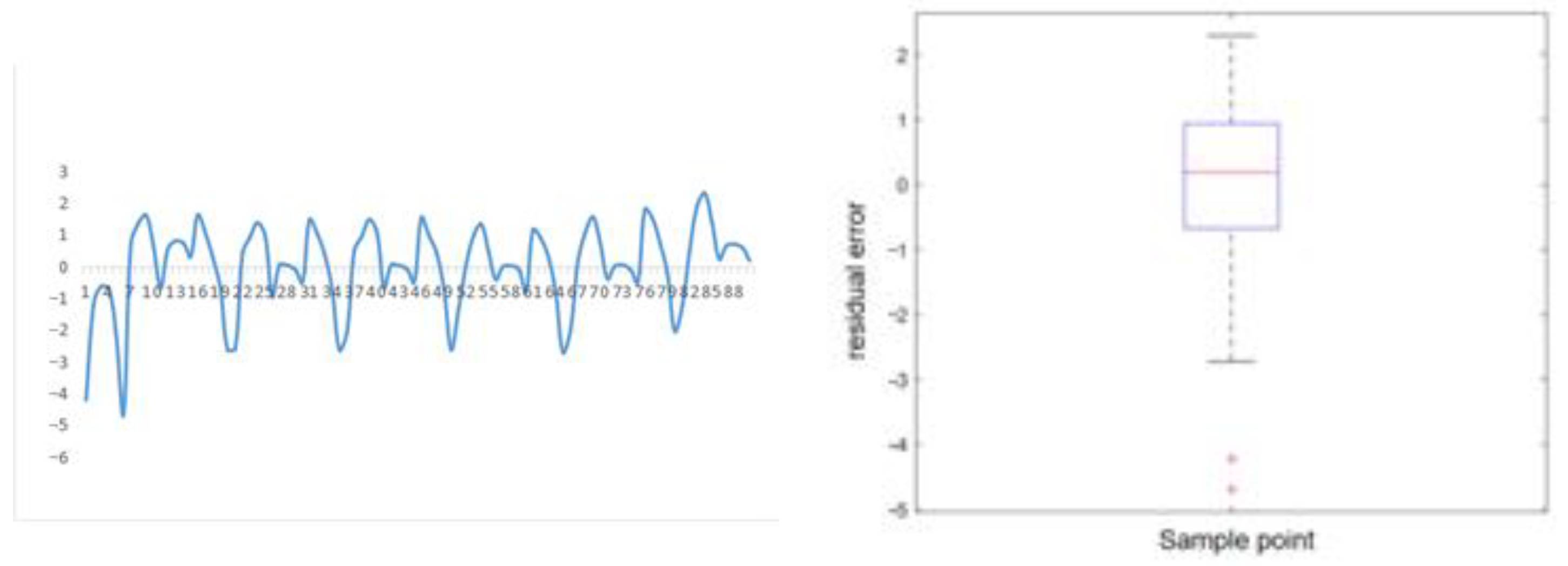
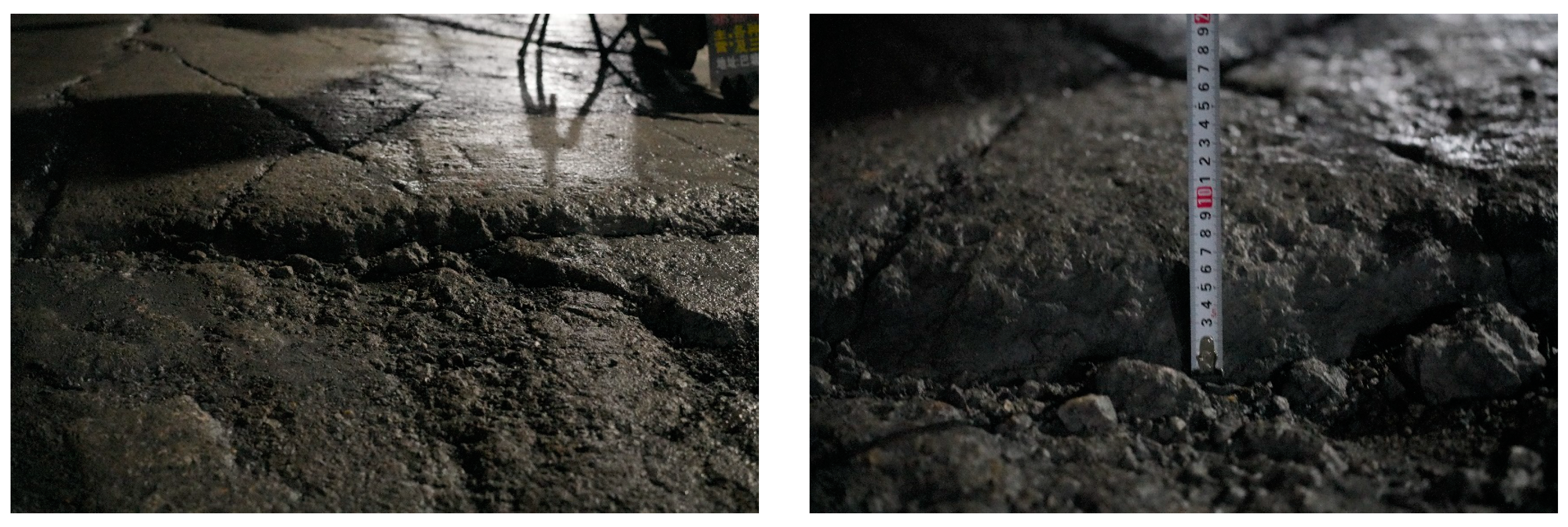

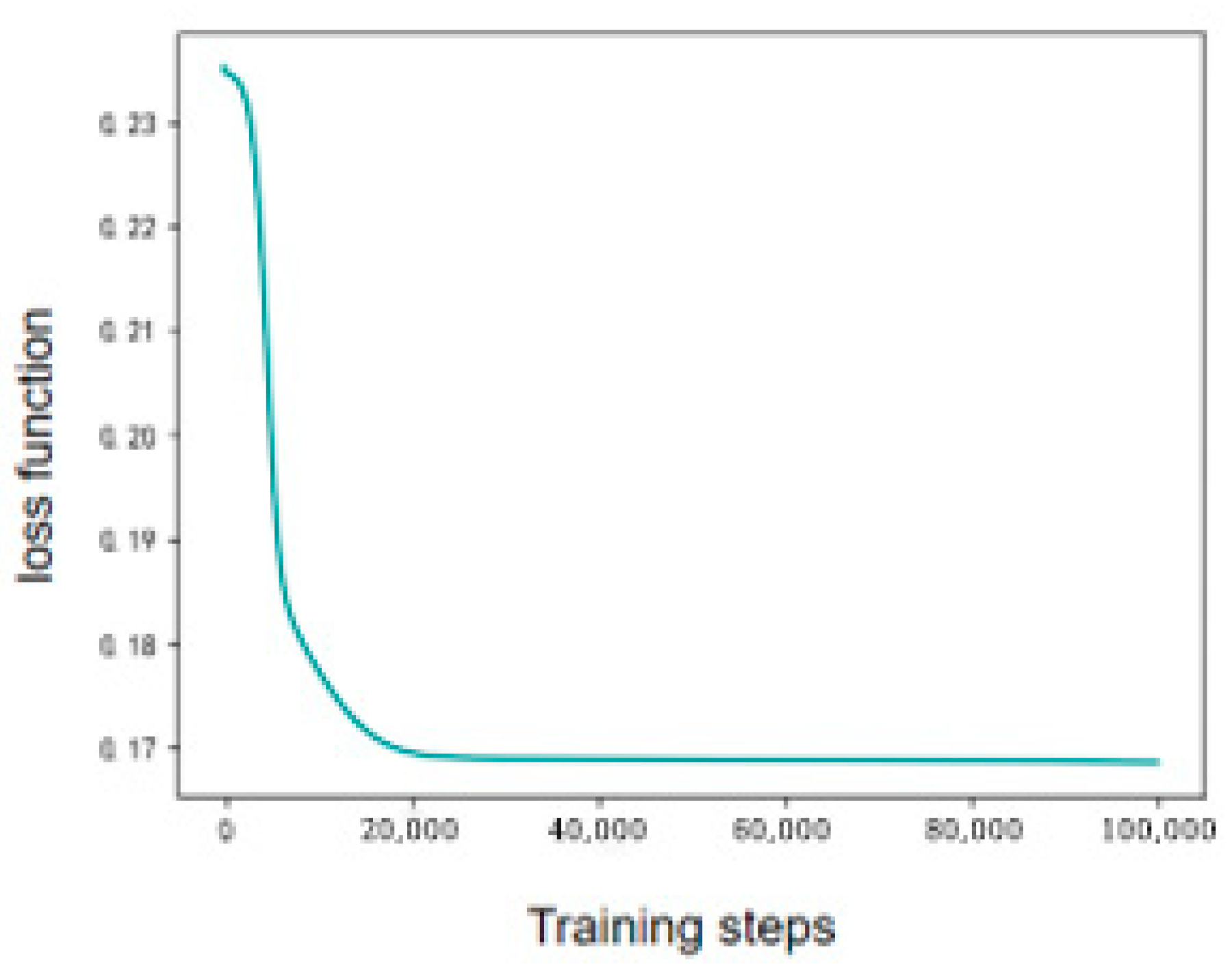
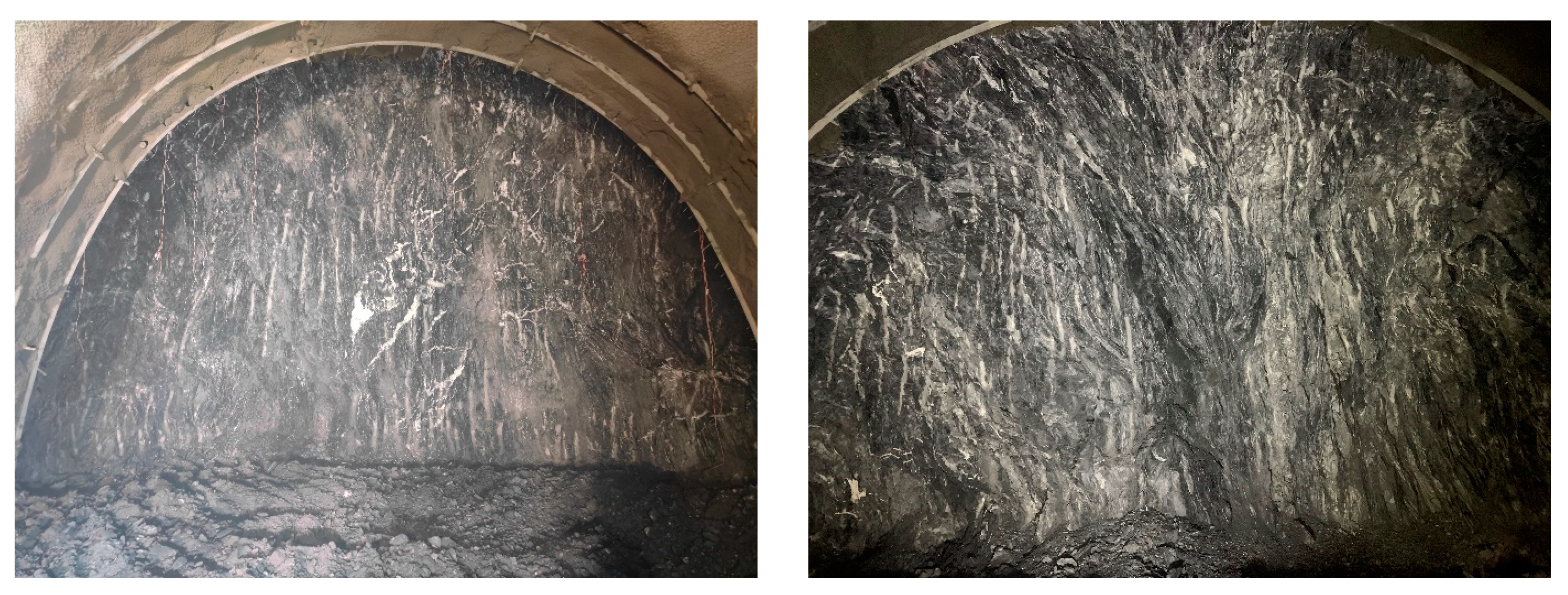
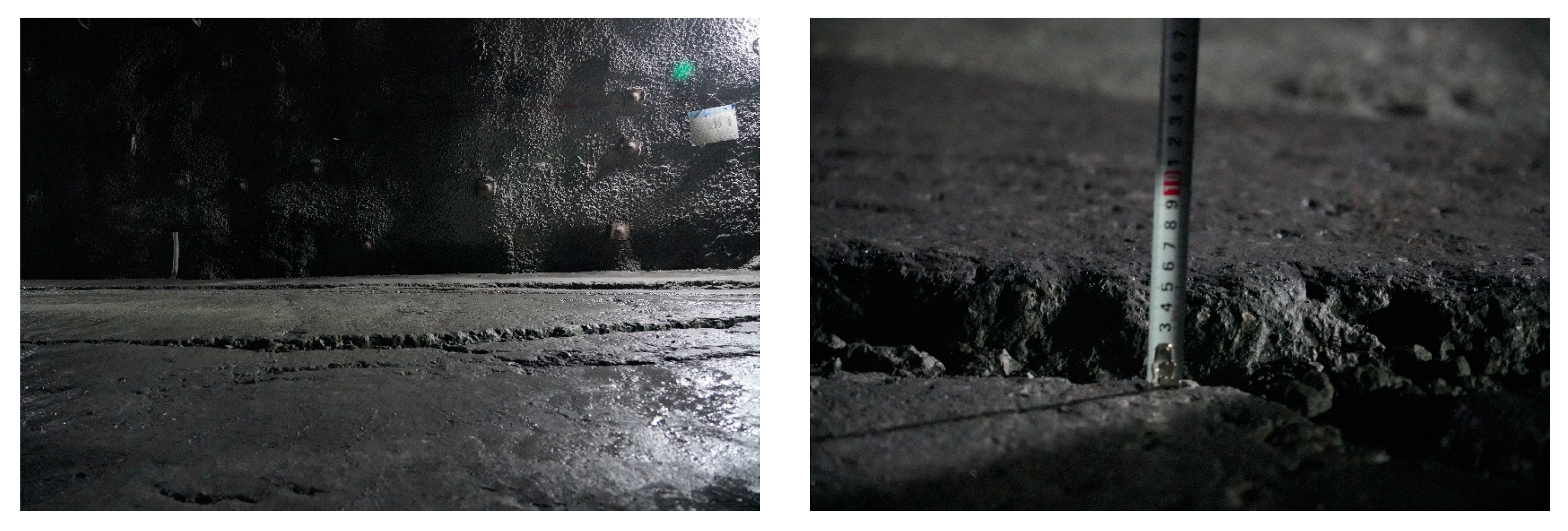
| Influencing Factors | Proportion (%) | Including Projects | Pie Chart |
|---|---|---|---|
| Groundwater | 42 | A: High-pressure water | 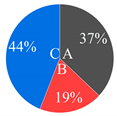 |
| B: Surrounding rock deterioration in water | |||
| C: Expansive rock expands with water | |||
| Expansive rock | 20 | A: Tuff and shale | 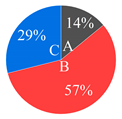 |
| B: Argillaceous sandstone | |||
| C: Silty clay | |||
| Ground stress | 5 | A: High ground stress |  |
| B: Tectonic stress | |||
| Structural matching | 10 | A: Insufficient understanding of bias voltage |  |
| B: Insufficient curvature of inverted arch | |||
| Construction quality | 23 | A: Insufficient thickness of inverted arch |  |
| B: The thickness of the filling layer is not uniform | |||
| C: The filling layer of the second lining is too early | |||
| D: The filling layer is not dense |
| Surrounding Rock Classification | Volumetric Weight/(kN/m3) | E/(GPa) | Poisson Ratio | Angle of Internal Friction/(°) | Cohesion/(MPa) |
|---|---|---|---|---|---|
| IIIb | 24 | 13 | 0.28 | 44 | 1.1 |
| IVb | 21.5 | 3.65 | 0.33 | 33 | 0.45 |
| Va | 19 | 1.65 | 0.37 | 24 | 0.16 |
| Vb | 16 | 1.15 | 0.45 | 21 | 0.0625 |
| Thin layer | 18 | 0.186 | 0.25 | 38 | 0.6 |
| Lateral Pressure Coefficient | Inclination Angle of Surrounding Rock/(°) | Hard Rock Thickness/cm | Thin Layer Thickness/cm | Elastic Modulus of Hard Rock Mass/Gpa | Depth of Tunnel/m |
|---|---|---|---|---|---|
| 0.5 | 0 | 10 | 1 | 13 | 100 |
| 1 | 5 | 30 | 3 | 10 | 200 |
| 1.5 | 10 | 50 | 5 | 6 | 300 |
| 2 | 15 | 70 | 7 | 3.65 | 400 |
| 3 | 20 | 90 | 9 | 1.5 | 500 |
| - | 25 | - | - | - | - |
| Origin | Square Sum of Type III | Degree of Freedom | Mean Square | F | Significance |
|---|---|---|---|---|---|
| Modified model | 10,190.906 a | 30 | 339.697 | 11.005 | 0.003 |
| Intercept | 4335.575 | 1 | 4335.575 | 140.458 | 0 |
| Side pressure coefficient | 604.816 | 4 | 151.204 | 4.899 | 0.042 |
| Inclination angle of surrounding rock | 35.976 | 5 | 7.195 | 0.233 | 0.934 |
| Hard rock thickness | 17.084 | 4 | 4.271 | 0.138 | 0.962 |
| Thin layer thickness | 291.86 | 4 | 72.965 | 2.364 | 0.166 |
| Elastic modulus of hard rock mass | 64.544 | 4 | 16.136 | 0.523 | 0.724 |
| Tunnel buried depth | 737.608 | 5 | 184.402 | 5.974 | 0.027 |
| Error | 185.204 | 6 | 30.867 | - | - |
| Total | 37,946.872 | 37 | - | - | - |
| Total after correction | 10,376.11 | 36 | - | - | - |
| Surrounding Rock Grade— Span (m)— Side Pressure Coefficient Inclination (°) | 0° | 5° | 10° | 15° | 20° | 25° |
|---|---|---|---|---|---|---|
| IIIb-8.83-0.5 | 16.79 | 16.21 | 17.99 | 17.56 | 17.14 | 16.53 |
| IIIb-8.83-1 | 15.40 | 14.93 | 15.76 | 15.54 | 15.22 | 14.44 |
| IIIb-8.83-1.5 | 13.22 | 12.89 | 13.57 | 13.42 | 13.29 | 12.78 |
| IIIb-8.83-2 | 12.74 | 12.52 | 13.60 | 13.44 | 13.02 | 11.84 |
| IIIb-8.83-3 | 10.28 | 10.13 | 10.54 | 10.28 | 9.33 | 9.06 |
| IIIb-10-0.5 | 16.95 | 17.36 | 17.44 | 17.46 | 17.34 | 17.87 |
| IIIb-10-1 | 14.41 | 15.41 | 17.61 | 14.11 | 12.96 | 15.28 |
| IIIb-10-1.5 | 13.60 | 13.27 | 20.66 | 12.73 | 14.22 | 17.14 |
| IIIb-10-2 | 13.05 | 13.77 | 24.53 | 14.83 | 18.40 | 22.11 |
| IIIb-10-3 | 15.57 | 16.74 | 29.57 | 28.77 | 28.26 | 27.64 |
| IIIb-13.0-0.5 | 18.99 | 18.52 | 19.77 | 19.15 | 19.09 | 17.84 |
| IIIb-13.0-1 | 15.41 | 14.48 | 15.16 | 15.06 | 14.53 | 14.21 |
| IIIb-13.0-1.5 | 19.99 | 18.46 | 21.79 | 21.22 | 20.88 | 18.21 |
| IIIb-13.0-2 | 18.69 | 17.74 | 18.42 | 18.50 | 17.91 | 17.62 |
| IIIb-13.0-3 | 16.96 | 16.16 | 16.83 | 17.28 | 16.66 | 16.46 |
| IVb-9.15-0.5 | 17.77 | 17.02 | 18.65 | 18.33 | 18.03 | 17.16 |
| IVb-9.15-1 | 18.90 | 18.23 | 18.70 | 20.28 | 18.54 | 17.52 |
| IVb-9.15-1.5 | 17.55 | 16.98 | 18.22 | 18.13 | 17.99 | 15.24 |
| IVb-9.15-2 | 13.75 | 13.27 | 13.86 | 13.28 | 11.96 | 9.97 |
| IVb-9.15-3 | 12.08 | 11.61 | 11.79 | 11.72 | 10.87 | 9.99 |
| IVb-10-0.5 | 20.56 | 20.72 | 21.16 | 21.09 | 20.94 | 21.34 |
| IVb-10-1 | 15.81 | 15.61 | 19.72 | 15.09 | 14.79 | 16.29 |
| IVb-10-1.5 | 11.74 | 11.08 | 19.84 | 11.32 | 17.00 | 15.55 |
| IVb-10-2 | 8.34 | 9.44 | 20.46 | 12.15 | 12.74 | 18.09 |
| IVb-10-3 | 5.07 | 3.00 | 3.13 | 4.90 | 2.89 | −1.30 |
| IVb-13.32-0.5 | 25.93 | 25.16 | 27.88 | 27.22 | 26.99 | 24.17 |
| IVb-13.32-1 | 24.89 | 23.29 | 24.93 | 24.28 | 24.18 | 23.97 |
| IVb-13.32-1.5 | 24.01 | 23.51 | 25.57 | 25.11 | 24.55 | 22.98 |
| IVb-13.32-2 | 21.63 | 20.26 | 21.31 | 25.28 | 21.17 | 20.88 |
| IVb-13.32-3 | 18.37 | 18.31 | 17.97 | 23.28 | 18.72 | 18.16 |
| Vb-9.37-0.5 | 22.35 | 21.94 | 23.20 | 21.42 | 18.67 | 17.75 |
| Vb-9.37-1 | 21.24 | 20.07 | 21.56 | 20.28 | 18.53 | 17.48 |
| Vb-9.37-1.5 | 15.56 | 14.28 | 16.31 | 15.94 | 15.30 | 14.48 |
| Vb-9.37-2 | 6.29 | 5.26 | 5.96 | 4.72 | 5.66 | 5.88 |
| Vb-9.37-3 | 0.53 | −0.63 | 0.41 | 26.28 | 0.14 | −0.64 |
| Vb-10-0.5 | 23.61 | 23.54 | 24.71 | 23.77 | 23.31 | 23.92 |
| Vb-10-1 | 20.08 | 19.67 | 23.82 | 19.56 | 19.28 | 20.88 |
| Vb-10-1.5 | 9.41 | 6.01 | 9.04 | 10.67 | 9.70 | 8.76 |
| Vb-10-2 | −6.77 | −7.98 | −8.96 | −8.30 | −8.58 | −5.32 |
| Vb-10-3 | −16.21 | −17.15 | −11.22 | −17.83 | −15.50 | −15.66 |
| Va-13.6-0.5 | 24.34 | 22.08 | 27.53 | 26.77 | 25.68 | 23.88 |
| Va-13.6-1 | 20.40 | 18.59 | 20.82 | 20.28 | 21.42 | 20.40 |
| Va-13.6-1.5 | 11.20 | 12.32 | 13.55 | 12.99 | 12.24 | 10.56 |
| Va-13.6-2 | −3.95 | −4.83 | −4.38 | −4.28 | −6.66 | −5.45 |
| Va-13.6-3 | −17.65 | −18.41 | −18.17 | −18.28 | −19.01 | −20.29 |
Disclaimer/Publisher’s Note: The statements, opinions and data contained in all publications are solely those of the individual author(s) and contributor(s) and not of MDPI and/or the editor(s). MDPI and/or the editor(s) disclaim responsibility for any injury to people or property resulting from any ideas, methods, instructions or products referred to in the content. |
© 2024 by the authors. Licensee MDPI, Basel, Switzerland. This article is an open access article distributed under the terms and conditions of the Creative Commons Attribution (CC BY) license (https://creativecommons.org/licenses/by/4.0/).
Share and Cite
Fan, R.; Chen, T.; Wang, S.; Jiang, H.; Yin, X. Study on Influencing Factors and Prediction of Tunnel Floor Heave in Gently Inclined Thin-Layered Rock Mass. Appl. Sci. 2024, 14, 7701. https://doi.org/10.3390/app14177701
Fan R, Chen T, Wang S, Jiang H, Yin X. Study on Influencing Factors and Prediction of Tunnel Floor Heave in Gently Inclined Thin-Layered Rock Mass. Applied Sciences. 2024; 14(17):7701. https://doi.org/10.3390/app14177701
Chicago/Turabian StyleFan, Rong, Tielin Chen, Shunyu Wang, Hao Jiang, and Xuexuan Yin. 2024. "Study on Influencing Factors and Prediction of Tunnel Floor Heave in Gently Inclined Thin-Layered Rock Mass" Applied Sciences 14, no. 17: 7701. https://doi.org/10.3390/app14177701





